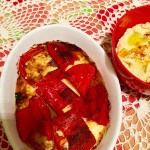Shrikhand – The evolution of flavoured cream and yoghurt

The decision to make Shrikhand was rather last moment. As my recipe devising notebook suggests, it was going to be a low fat cheese cake, where I leave out the cheese! Since leaving out the cheese in a cheesecake would have been a criminal offence I ended up making Shrikhand instead. I did tweak the traditional recipe, a bit, because I am not Maharashtrian or Gujarati, I haven’t seen Shrikhand made at home. Bengal is more popular for its mishti doi than the mass produced Amul Shrikhand that comes in coloured tubs. I quite disliked the elaichi (cardamom) flavour as I vividly remember. However, learning to cook and experimenting with food has its privileges, you can ignore the things you don’t like. Like all cardamom flavoured food and drink in my case. I detest masala chai, chai latte and all its forms wholeheartedly. I am more of a Darjeeling tea or hot and spicy lemon tea sort of person. Going back to the Shrikhand.
Shrikhand is a popular yoghurt based dessert from Western India, Maharashtrian and Gujarati cuisine to be precise. While looking for the history and etymology of Shrikhand I came across a few interesting facts. A fellow blogger, Evolving Tastes, suggests that K. T. Achaya’s ‘Indian Food: A Historical Companion’, mentions that shrikhand in its present form appeared in food writings in Kannada as early as 1025 AD. It refers to ‘Lokopakara’ of Chavundaraya, which says that it was known as shikarini at that time. Also, ‘Supa Shastra’ by the poet Mangarasa refers to shrikhand in 1594 AD.
However other sources and evidence also suggest that the etymology of the word Shrikhand comes from ksheer, thickened milk in Sanskrit and Qand, sweet in Parsi. This makes sense to me, as the dish might be of Persian origin brought to Western India by the Parsi(Zorastrian) settlers, who emigrated from Iran to India around 8th to 10th century AD. It is interesting that Shrikhand was mentioned in the food writings from Kannada around the same time.
My recipe is quite simple, really, as I was cooking for a party of 10. So, following the traditional route by straining yoghurt was not something that I wished or had the time to do. The key ingredients of my recipe were Greek yoghurt and low fat double cream. The name low fat double cream is such an oxymoron but apparently double cream can be low fat!

Ingredients
- 500 ml Greek Yoghurt
- 300 ml Double Cream
- Icing sugar to taste (approximately 100 grams)
- saffron (6 strands)
- rose water (to taste)
- chopped almonds and/or pistachios (as much or as little as you like)
Preparation: 30 mins
Adding the double cream and the icing sugar was my fail-safe method to ensure that the dessert holds its shape. I constantly worried whether the Greek yoghurt would start becoming watery and runny. However it turned out to be an amazing dessert and I am never going to leave out the double cream.
Beat the double cream with few table spoons of icing sugar till it forms soft peaks, leave it in the fridge to chill while you beat the yoghurt. Put some more icing sugar or caster sugar in the yoghurt and beat it till its smooth and creamy. in two tablespoons of warm milk and one tablespoon of rose water soak your strands of saffron. How many strands you put in depends on your tastes. Both saffron and rose water can be quite strong so don’t put in too much of it unless you love it. I wanted my Shrikhand delicately flavoured. Make sure you don’t put too much milk or rose water because the lack of liquid is what makes it successful.
Take the chilled cream out of the fridge and blend the golden orange liquid of saffron and rose water along with the strands into the cream and beat it gently. Then fold the yoghurt into the cream and add the chopped nuts to it. Chill it in the fridge overnight or for a few hours. Garnish with more nuts or chopped fruits while serving.
Leaving the saffron strands in the cream works wonders because the saffron doesn’t stop leaking colour and streaks your shrikhand with psychedelic golden colour.
My recipe was inspired by another Indian delicacy, Nimish. Nimish is a cloud of rose flavoured cream, a dessert served in Lucknow. Although it sounded fantastic, I’ve never had the opportunity to visit Lucknow or eat it. My blend of traditional recipes of Shrikhand and Nimish is my tribute to the traditional desserts of India.
A friend of mine shared a traditional Shrikhand recipe, handed down from father to son, in a Gujarati village, with me.
Written by Amrita Dasgupta - Visit my blog for more food and travel storiesSuspend 2 kilos of curd wrapped in a clean white cloth from the ceiling overnight to let the water drip away. Next morning…take it down and scoop out gently onto a plate. Then tie another thin and clean white cloth (cotton best) around the top of a stockpot tightly. Scoop 2 large spoons of the solid curd onto this cloth and add sugar to taste (usually 1 spoon full). Then mash, mix and push with the back of a ladle so that the mixture is driven through the cloth into the container as a finely kneaded and mixed paste. Repeat the procedure for the entire amount of hung curd. It would take me around 2 hours and an aching forearm to accomplish. Then add some kesar (saffron) for colour and enhanced taste. sliced badams (nuts), apricots etc. and mix the whole thing. Use same things to garnish. Then chill it in fridge for couple of hours.. never in the freezer though..while you make small round luchis (fried flat bread)to go with it.
That’s how I know and do it….and it’s done in villages… hand taught from father to son…
I love to travel, discover new things, experience new cultures and then I get back home and experiment with the new food and recipes I discovered on my travels. My blog is about all those life experiences. If you’ve enjoyed this post, keep in touch with Drifting Traveller on Twitter and Facebook or by adding my blog to your RSS feed. Follow my blog with Bloglovin or Networked Blogs! If you really like reading the Drifting Traveller why not share it with people you know who'd like to read it too.


Yumm! I am sharing it 🙂
🙂 Thank you!
Sounds tasty and good but you haven’t mentioned the proportion of each ingredient.
Updated 🙂